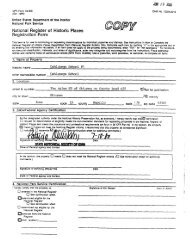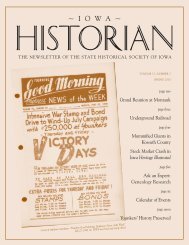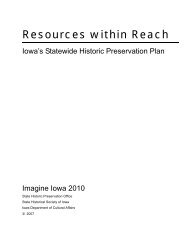Iowa in World War I
Iowa in World War I
Iowa in World War I
- No tags were found...
Create successful ePaper yourself
Turn your PDF publications into a flip-book with our unique Google optimized e-Paper software.
Learn more at:www.iowaflags.org<strong>Iowa</strong> <strong>in</strong> <strong>World</strong> <strong>War</strong> IIn the days immediately before the declaration ofwar, President Wilson took a prelim<strong>in</strong>ary step towardread<strong>in</strong>ess for entry <strong>in</strong>to the conflict. On March 25,1917, he issued a proclamation that called someof each state’s National Guard <strong>in</strong>to active service.At that time the <strong>Iowa</strong> National Guard consistedof three <strong>in</strong>fantry regiments, one cavalry squadron,one field artillery battalion, one company of eng<strong>in</strong>eers,and a field hospital. The 1st <strong>Iowa</strong> Infantry was calledup immediately and placed on duty guard<strong>in</strong>g bridgesand munitions plants. Through the spr<strong>in</strong>g and earlysummer, more units were gradually called <strong>in</strong>toservice. On July 3, President Wilson issued anotherproclamation call<strong>in</strong>g up all National Guard unitsthroughout the country and plac<strong>in</strong>g them <strong>in</strong>federal service.The <strong>Iowa</strong> National Guard had actually been activeshortly before the president’s call. A year before therehad been disturbances along the Mexican border.Mexico was <strong>in</strong> the midst of revolution and civil war,and <strong>in</strong> March, 1916, General Francisco (Pancho) Villahad attacked an army garrison at Columbus, NewMexico. At first, the National Guards of only threestates, Arizona, New Mexico, and Texas, had beencalled <strong>in</strong>to federal service. With<strong>in</strong> several months,however, the entire National Guard was called toactive duty. All units of the <strong>Iowa</strong> National Guardwere mustered <strong>in</strong>to federal service and sent to theMexican border area <strong>in</strong> south Texas. As the crisis withGermany grew <strong>in</strong> early 1917, many of the NationalGuard units were withdrawn from the border area.<strong>Iowa</strong>’s National Guard units were mustered out offederal service <strong>in</strong> January, 1917. The results of theMexican expedition were <strong>in</strong>conclusive, but the tra<strong>in</strong><strong>in</strong>gthe Guard units received was helpful as they were remustered<strong>in</strong>to federal service several months later forthe war aga<strong>in</strong>st the Central Powers.After the declaration of war, additional units wereraised <strong>in</strong> <strong>Iowa</strong>. They <strong>in</strong>cluded three more batteriesof field artillery, two additional eng<strong>in</strong>eer companies,an ammunition tra<strong>in</strong>, a signal corps company,an ambulance company, and one more field hospital.Active recruit<strong>in</strong>g began at once because bothGovernor William Hard<strong>in</strong>g and Adjutant General GuyLogan were concerned over the refusal of some <strong>Iowa</strong>National Guardsmen to be sworn <strong>in</strong>to federal service.Although they had been stationed along the border,they had not seen active service and some of themen refused the federal oath aga<strong>in</strong>. However, thoserefus<strong>in</strong>g to take the oath turned out to be a very t<strong>in</strong>ypercentage. Also, many other <strong>Iowa</strong>ns who had notpreviously served flocked to the recruit<strong>in</strong>g stations tosign up. Recruit<strong>in</strong>g was helped by a campaign that thegeneral public heartily jo<strong>in</strong>ed. It was common to seerecruit<strong>in</strong>g posters <strong>in</strong> store w<strong>in</strong>dows and on sides ofcommercial build<strong>in</strong>gs. Recruit<strong>in</strong>g slides were shown <strong>in</strong>movie houses. Many organizations such as the GrandArmy of the Republic, Camps of Spanish <strong>War</strong> Veterans,Chambers of Commerce, Rotary Clubs, Knightsof Columbus, and lodges helped to recruit. Manymembers of the <strong>Iowa</strong> State Manufacturers Associationpromised that men who enlisted would get their jobsback after the war. Other organizations followed suit,<strong>in</strong>clud<strong>in</strong>g the <strong>Iowa</strong> Coal M<strong>in</strong>ers’ Association,the <strong>Iowa</strong> State Bankers’ Association, all <strong>Iowa</strong> <strong>in</strong>surancecompanies, Clay Workers State Association, WholesaleGrocers Association, Retail Merchants Association,and the <strong>Iowa</strong> State Druggists Association as well asmany other smaller employers.Altogether about 110,000 <strong>Iowa</strong>ns served <strong>in</strong> theArmy, Navy, and Mar<strong>in</strong>e Corps. Of that number, 9,719<strong>Iowa</strong> National Guardsmen served while about 98,000were <strong>in</strong>ducted <strong>in</strong>to the armed services through theSelective Service law. Most of the Guard units servedCont<strong>in</strong>ued...
Learn more at:www.iowaflags.org<strong>Iowa</strong> <strong>in</strong> <strong>World</strong> <strong>War</strong> I:(cont<strong>in</strong>ued)a year at Camp Cody, New Mexico, except the 168thInfantry, which went to Europe relatively early <strong>in</strong>the war. Of those <strong>in</strong>ducted through the SelectiveService, about half received tra<strong>in</strong><strong>in</strong>g at Camp Dodge,just northwest of Des Mo<strong>in</strong>es, while the other halfreceived their tra<strong>in</strong><strong>in</strong>g at military camps <strong>in</strong> widelyscattered locations across the United States.Camp Dodge became one of the most <strong>in</strong>tensivetra<strong>in</strong><strong>in</strong>g camps <strong>in</strong> the country dur<strong>in</strong>g <strong>World</strong> <strong>War</strong> I.Named for Major General Grenville M. Dodge,a famous Civil <strong>War</strong> commander and chief eng<strong>in</strong>eerof the Transcont<strong>in</strong>ental Railroad, the camp was firstestablished <strong>in</strong> 1907 as a tra<strong>in</strong><strong>in</strong>g ground for the <strong>Iowa</strong>National Guard. The orig<strong>in</strong>al camp was only 78 acresbut had been expanded to 570 acres by 1917. In June,1917, the U.S. Army Selection Board chose CampDodge to be one of sixteen regional tra<strong>in</strong><strong>in</strong>g campsfor the United States Army. The camp expandedfrom 570 acres to 6,400 acres and was used for basictra<strong>in</strong><strong>in</strong>g for recruits from <strong>Iowa</strong>, Nebraska, M<strong>in</strong>nesota,North Dakota, and South Dakota.Due to America’s relative lack of militarypreparedness at the time of the war declaration, thedevelopment of Camp Dodge became a top priority.In just four months, from July to November, 1917,a major military camp arose there. Thirty barrackswere constructed, each be<strong>in</strong>g a two-story build<strong>in</strong>g140 feet long and 43 feet wide which could house150 men. Two headquarters build<strong>in</strong>gs, a 3,000-seatauditorium, a hospital, three fire stations, post offices,libraries, railroad depots, eight YMCA halls, a YWCAauditorium and centers for the Knights of Columbus,the Lutheran Brotherhood, and the Jewish WelfareService were all built <strong>in</strong> this short period of time.Dur<strong>in</strong>g the last year of the war, Camp Dodgeoperated as a self-sufficient community for 40,000people. It became the headquarters for the 88thDivision, commanded by Major General EdwardPlummer. The Division had 27,000 men <strong>in</strong>clud<strong>in</strong>g8,000 <strong>Iowa</strong>ns. A total of 80,000 recruits receivedtheir basic tra<strong>in</strong><strong>in</strong>g at Camp Dodge and then wentelsewhere to receive advanced tra<strong>in</strong><strong>in</strong>g before be<strong>in</strong>gsent to Europe for active duty. In July, 1918, the <strong>War</strong>Department ordered the 88th Division <strong>in</strong>to activecombat service. By September, the entire division was<strong>in</strong> Europe. After the 88th Division left, a new 19thDivision cont<strong>in</strong>ued tra<strong>in</strong><strong>in</strong>g, but the Spanish Influenzaepidemic of 1918 created major problems.MAIN AVENUE AND DEPOT STREET - CAMP DODGE, 1918Image from The Library of Congress • www.loc.gov
Learn more at:www.iowaflags.org<strong>Iowa</strong> <strong>in</strong> <strong>World</strong> <strong>War</strong> I:(cont<strong>in</strong>ued)organized at Camp Dodge, <strong>in</strong>clud<strong>in</strong>g the 163rd DepotBrigade, 804th Pioneer Infantry Regiment (Colored),the 366th Infantry Regiment, and the 414th PioneerInfantry Regiment.As mentioned, most of the <strong>Iowa</strong> National Guard,except the 168th Infantry, was sent to Camp Cody,New Mexico for extended tra<strong>in</strong><strong>in</strong>g and assigned to the34th Division. For most of the <strong>Iowa</strong> boys who wereused to the green pastures and fields of corn and hay<strong>in</strong> the Hawkeye State, Camp Cody was a bit ofa shock. The camp was <strong>in</strong> the midst of a desert,and a recent drought had killed many longhorn cattle.Their numerous carcasses and bleached skulls wereto be found <strong>in</strong> the area. Constant w<strong>in</strong>d whippedthe desert sand around, caus<strong>in</strong>g one corporal towrite home that he had “sand <strong>in</strong> his eyes, ears, nose,and mess kit.” Due to these conditions, the 34thDivision was nicknamed as the “Sandstorm Division.”The <strong>in</strong>signia of the 34th Division was developed byan aspir<strong>in</strong>g young artist from Cedar Rapids. Marv<strong>in</strong>Cone was then serv<strong>in</strong>g with the HeadquartersCompany, 67th Brigade at Camp Cody and entereda competition for devis<strong>in</strong>g an <strong>in</strong>signia for the division.His design showed a bleached white buffalo skullcentered on a red Indian water jug. Cone had noticedthe abundance of both Indian jugs and bleached buffaloskulls <strong>in</strong> the area near Camp Cody and made anappropriate design for the division from these objects.His design won the contest and the design wasidentified with the division until some modificationswere made to it dur<strong>in</strong>g <strong>World</strong> <strong>War</strong> II. After <strong>World</strong><strong>War</strong> I, Cone taught at Coe College for more thanforty years and worked closely with Grant Wood atthe Stone City Colony and Art School <strong>in</strong> the 1930’s.The SHSI collection <strong>in</strong>cludes flags from nearly allthe <strong>Iowa</strong> units that served <strong>in</strong> <strong>World</strong> <strong>War</strong> I. The surveywill beg<strong>in</strong> with flags from the 168th Infantry, the mostactive of those units and virtually the only one thatengaged <strong>in</strong> direct military action aga<strong>in</strong>st the CentralPowers. As was the case with the Spanish-American<strong>War</strong>, the units that did not serve directly on the frontl<strong>in</strong>e simply did not arrive <strong>in</strong> time before the armisticeor were used as replacements for other units.HUMAN STATUE OF LIBERTY - 18,000 OFFICERS AND MENCAMP DODGE, 1917-18Image from The Library of Congress • www.loc.gov







